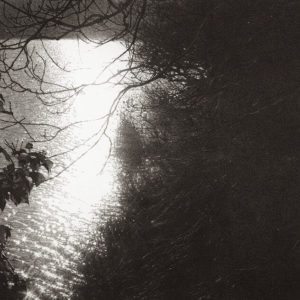I need only look up to see that darkness is as deep and boundless as the Cosmos itself.
David Hinton, Hunger Mountain
Listen to the birds singing outside. But they are not outside. There is no border between them and us: no separation.
Zen Master Hogen, The Other Shore
Consider the hair on a bee’s leg, or the tender fluff of the feathers of a moorhen’s belly, or a single ripple on the surface of a moonlit estuary. In this hasty electronic age we have almost lost the capacity to observe such minute and exquisite details of the everyday, the small miracles of natural life that surround us, eloquent in their silent testimony. Sarah Gillespie knows how to look, and to listen to these fleeting or fragmentary elements: in her recent work each is imbued with a vital energy of its own that brings the insect, or the bird, or the landscape out of stillness into life. Nothing escapes the intensity of her gaze as she guides the pen or charcoal that tracks the pulse of the living world, not simply transcribing but translating every quiver of it to a point where representation and abstraction fuse as the marks on the paper build up a life and a raison d’être of their own. Somewhere between the hand and the image, the outer and the inner worlds coalesce in what it is sometimes hard to believe are drawings: a drawn contemplation of things that are so familiar and yet profoundly transformed by the creative process.
There are subjects that have become frozen in the moment of death, yet by being drawn generate a new energy, living again through charcoal and paper; there are subjects that are never still, but change from moment to moment: water that is always there yet never for a second the same, trees that have stood against the elements and that through the alchemical marriage of their burned element and ink come to mark an endlessly strengthening resistance to time. There is a sometimes dazzling light that comes from nothing, and is nothing but blank paper, and yet, in the manner of Zen paintings, is the nothingness that gives everything coherence and a meaning.
The calm contemplation of the Devon landscape, and the infinitely slow process of transcribing it to plate or paper, are part of an extended meditation in which all our expectations are reversed. Paradoxically, the depths of velvet darkness and their ramifications become a force field vibrating with life; the still light brings emptiness, but a void that is the intense space of an inner vision that we are invited to share. At times the merest touch of moon- or sunlight brings warmth and colour flooding in; at others its very absence makes you feel the swift advance of storm clouds across the bay, just as in the making of the image, the clouds of charcoal advanced, but how much more slowly, across the paper. In the long, patient, mindful act of creation, all is stilled to the single point that makes the mark or leaves the white unmarked, the better to make visible the turbulent chiaroscuro of the forces of nature.
Years ago, when she was still a student, Sarah Gillespie produced an image of a female form emerging from the darkness into the light. You sensed the speed of the flight, but also the energy and anxiety of purpose: she knew where she wanted to go, even if she was not yet sure how she would get there. Nothing could be more different from the images in this exhibition. The speed has gone, the purpose is fulfilled. There is now a quiet certainty of hand and vision, and a stilling of time that comes from the intense calm of her gaze and the mastery of her technique. If we are to enter her world it must be on her terms: a quick glance will not suffice. We need to look as intently as she has, to contemplate as patiently the woods and the water, to see beyond the networks of branches and the interweaving of currents, to the life-force that inhabits them and that inspires her work. Indifference is not possible: if we can open ourselves to this world and experience its energy to the full, we too can be transformed by it and look with a new eye at what surrounds us, and is within us.
Nicholas Mann
October 2014
